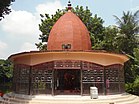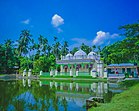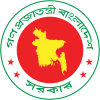
Barisal Division is one of the eight administrative divisions of Bangladesh. Located in the south-central part of the country, it has an area of 13,644.85 km2 (5,268.31 sq mi), and a population of 9,100,102 at the 2011 Census. It is the least populous Division in Bangladesh. It is bounded by Dhaka Division on the north, the Bay of Bengal on the south, Chittagong Division on the east and Khulna Division on the west. The administrative capital, Barisal city, lies in the Padma River delta on an offshoot of the Arial Khan River. Barisal division is criss-crossed by numerous rivers that earned it the nickname Dhan-Nodi-Khal, Ei tin-e Borishal.

Abul Kasem Fazlul Huq, popularly known as Sher-e-Bangla, was a Bengali lawyer and politician who presented the Lahore Resolution which had the objective of creating an independent Pakistan. He also served as the first and longest Prime Minister of Bengal during the British Raj.

Faridpur District is a district in south-central Bangladesh. It is a part of the Dhaka Division. It is bounded by the Padma River to the northeast. The district was named for its headquarters Faridpur town, which itself was named for Farīd-ud-Dīn Masʿūd, a 13th-century Sufi saint. A separate district was created by severing Dhaka district in 1786 and was called Dacca Jelalpur. A municipality was established in 1869. Historically, the town was known as Fatehabad. It was also called Haveli Mahal Fatehabad.

Barguna is a district in the division of Barisal, in southern Bangladesh. Barguna subdivision was established in 1969 and promoted to a district on 28 February 1984.

Patuakhali is a district in south-central Bangladesh in the Barisal Division. This district is the main entrance for the beach of Kuakata.
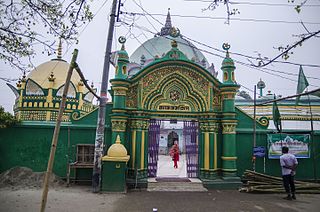
Sirajganj District is a district in the North Bengal region of Bangladesh, located in the Rajshahi Division. It is an economically important district of Bangladesh. Sirajganj district is the 25th largest district by area and 9th largest district by population in Bangladesh. It is known as the gateway to North Bengal.
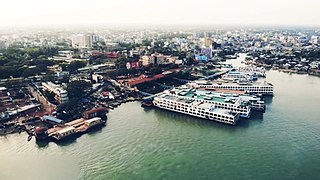
Barisal, officially known as Barishal, is a major city that lies on the banks of the Kirtankhola river in south-central Bangladesh. It is the largest city and the administrative headquarter of both Barisal District and Barisal Division. It is one of the oldest municipalities and river ports of the country. The city was once called the Venice of the East or the Venice of Bengal.

Govt. Brojomohun College, Barishal is one of the oldest institutions of higher education in Bangladesh. It is located in the city of Barishal in south-western Bangladesh.
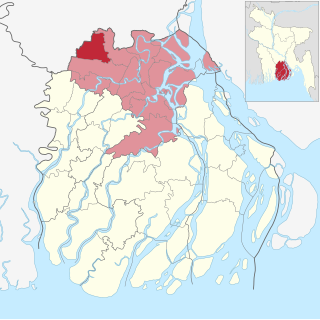
Agailjhara is an upazila (sub-district) of southern Bangladesh's Barisal District, part of the Barisal Division.

Banaripara is an Upazila of Barishal District in the Division of Barishal in southern-central Bangladesh.
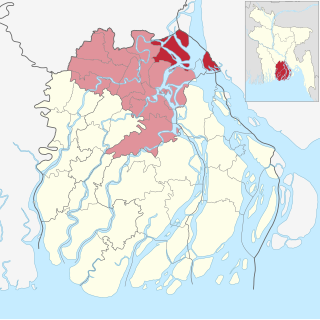
Hizla is the largest upazila (sub-district) of southern Bangladesh's Barisal District.

Mehendigonj is an Upazila of Barisal District in the Division of Barisal, Bangladesh. Mehendigonj is popularly known as Patarhat by the local people.
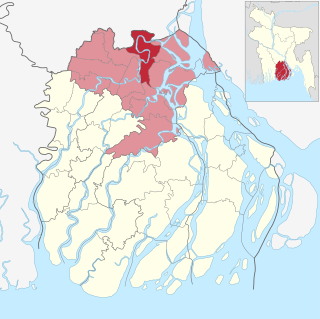
Muladi is an Upazila of Barishal District in the Division of Barishal, Bangladesh.

Jhalakathi Sadar is an upazila of Jhalokati District in the Division of Barisal, Bangladesh.

Nalchity is an upazila of Jhalokati District in the division of Barisal, Bangladesh.

Rajapur is an upazila (sub-district) of southern Bangladesh's Jhalokati District, part of the Barisal Division.
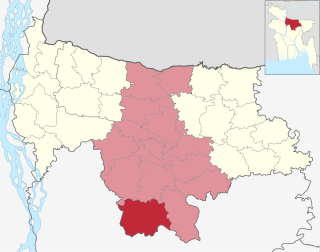
Bhaluka is an upazila of the Mymensingh District located in Bangladesh. It is one of the oldest small business hubs in the area.

Barishal Zilla School, popularly known as BZS, is a public educational institution for boys, located in Barisal, Bangladesh. It was the first high school established in Barisal Division. Founded as Barisal English School on 23 December 1829 by W. N. Garrett, it began with 27 students. In 1853, the school was renamed Barisal Zilla School.

Khan Bahadur Hasem Ali Khan was a Bengali politician, lawyer, peasant movement leader and social worker. He was a close associate of A. K. Fazlul Huq. He became a Minister in the Bengal Legislature in 1941 in the second cabinet led by Huq. During his political life, he tried to establish rights of farmers and common people. He was conferred the title of Khan Bahadur by the British Raj as recognition of his contribution for maintaining peaceful relations between people of different faiths.
Govt. Fazlul Huq College is a public institution for higher education in Chakhar, a small town in Barisal district in Bangladesh. It was founded in 1940 by then Prime Minister of Bengal A K Fazlul Huq with a view to creating opportunity of higher education to underprivileged students in rural areas. It offers Higher Secondary School Certificate (HSC), as well as 3 years degree(pass) courses and 4 years honours programs which divisions are affiliated to the National University, Bangladesh. It is the second oldest and largest college in Barisal division and was previously affiliated with University of Calcutta before partition and University of Dhaka after formation of Pakistan and Bangladesh respectively.










